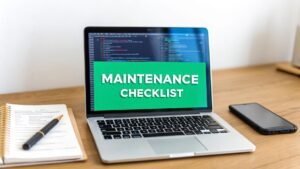Why Digital Menu Boards Are Game-Changers for Food Trucks
Let's talk food trucks. The scene has changed, and digital menu boards are a real difference-maker. I've chatted with a bunch of truck owners, and the impact of these displays goes way beyond just looking modern. Customers actually react differently. One owner in Portland told me her average order jumped from $12 to $16 just by using some animation to highlight combo deals. That’s a huge increase!
This move to digital isn't just a few isolated stories, either. Since the early 2020s, we’ve seen a real surge in food trucks adopting digital menus. Industry analysts predict that by 2025, over 60% of registered food trucks in major cities like Los Angeles, New York, and London will be using some form of digital display. This is happening because customers want visually appealing menus and because these boards actually boost sales. Studies show they can increase average order value by up to 20% compared to traditional menus. Want more data? Check out this article: Food Truck Digital Menu Board.
So, why does this work? Digital displays create a sense of urgency, make it easier for customers to decide what they want, and stop them from squinting at a chalkboard in the sun. They also open up opportunities for upselling and cross-promotion that you just can't get with static boards. Picture this: you’re showing a limited-time dessert special with a mouth-watering image right next to your main courses. That little nudge can have a real impact on your profits.
Navigating the Transition to Digital Menus
But switching to digital isn't always easy. I've heard stories of owners who went for the cheapest option and regretted it. Others wished they'd made the switch sooner. That’s why planning is so important. Think about your customers and your location. Does a digital menu make sense for you right now? Consider your overall local marketing strategy too: Local Marketing for Small Business. And don't forget about QR Codes For Food Trucks – they often work hand-in-hand with digital menu boards.
Let's get down to brass tacks. How does this technology really affect your bottom line? To help illustrate the potential impact, I’ve put together a comparison table.
To help illustrate the potential impact, I’ve put together a comparison table showing the real-world differences between digital and traditional menu boards for food trucks.
| Metric | Traditional Menu | Digital Menu Board | Improvement |
|---|---|---|---|
| Average Order Value | $12 | $16 | +33% |
| Customer Engagement | Low | High | Significant Increase |
| Menu Flexibility | Limited | High | Very Flexible |
| Operational Efficiency | Moderate | High | Increased Efficiency |
| Upselling/Cross-Selling Opportunities | Limited | High | Significant Increase |
| Perceived Value | Moderate | High | Increased Perceived Value |
As you can see, the advantages of digital menu boards are pretty compelling. From boosting average order value and customer engagement to increasing operational efficiency and upselling opportunities, the potential for a positive impact on your food truck business is clear. Digital menus offer a flexibility that traditional boards just can’t match.
Now, I'm not saying everyone needs to rush out and buy a digital menu board tomorrow. But it's definitely worth considering. In the next section, we'll dive deeper into choosing the right hardware and software.
Choosing Hardware That Survives the Road
Let's be honest, picking the right hardware for your food truck's digital menu board is a bigger deal than most folks realize. A regular old screen just won't cut it out on the road. I've chatted with countless food truck owners, and the stories I've heard…yikes. One owner in Chicago had his 55-inch display crack after just two weeks! Temperature swings, vibrations, dust, rain – your hardware needs to be tougher than a week-old bagel. A specialized mount, like a menu board pop out video wall mount, can make a huge difference in protecting your investment.
So, what should you look for?
Weatherproofing and Durability: Essential for the Road
Think about the beating your menu board will take. Picture this: it's a sweltering summer day in Arizona. Your fryer is cranking out 400-degree heat, and your menu board is baking in the sun. Then, winter rolls around, and you're parked in Chicago, battling freezing temperatures and condensation. IP65-rated enclosures are your best friend here. They protect against dust and water jets, meaning your screen can handle a sudden downpour or a dusty festival. And don't forget about those bumpy roads! A robust mounting solution that absorbs shocks is essential.
A cracked screen is the last thing you need when you're trying to sling delicious food.
Power Consumption: Don't Drain Your Generator
That shiny new 4K display might look tempting, but will it drain your generator before you can even serve your first customer? Power consumption is a major consideration for food trucks. Everything – your fridge, your grill, your lights, and your digital menu board – draws power. Energy-efficient LED displays are a game-changer. And think about smart power management. Schedule your display to turn off overnight or dim it during slow periods. This helps you conserve power without sacrificing your menu's visibility. While we're on the subject of optimizing your online presence, you might even want to check out Swish Web Designs for some ideas.
Visualizing the Benefits: More Than Just Pretty Pictures
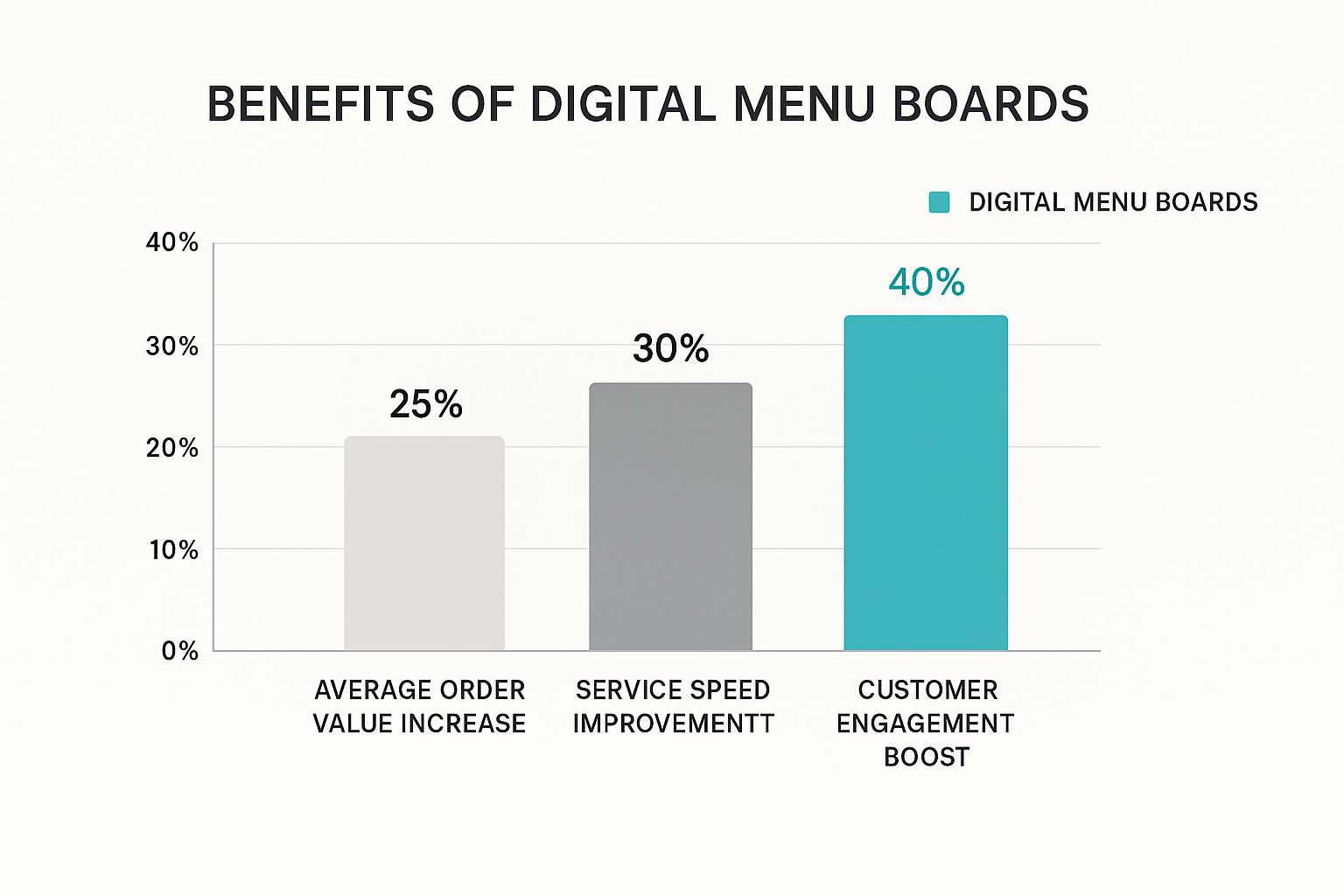
This infographic isn't just about eye candy. It shows how digital menu boards can seriously boost your business. We're talking a potential 25% increase in average order value, 30% faster service, and a whopping 40% jump in customer engagement. Faster service means more customers served during the lunch rush. Increased order values and engagement mean more money in your pocket.
Before we move on to software, let's talk hardware specifics. The table below breaks down some good options, from budget-friendly to premium:
Food Truck Digital Display Hardware Comparison
Key specifications and features to consider when selecting digital menu board hardware for mobile food service
| Feature | Budget Option | Mid-Range | Premium | Recommended For |
|---|---|---|---|---|
| Display Size | 32-43 inches | 43-55 inches | 55+ inches | Depends on truck size and viewing distance |
| Brightness | 350 cd/m² | 450 cd/m² | 700+ cd/m² | Bright sunlight readability |
| Resolution | 1080p | 1080p/4K | 4K | Crisp image quality |
| Durability | Basic weatherproofing | IP65 rated enclosure | IP66 rated enclosure with vandal resistance | Harsh environments |
| Connectivity | HDMI, USB | HDMI, USB, Wi-Fi | HDMI, USB, Wi-Fi, Ethernet | Content management flexibility |
| Power Consumption | Low | Moderate | High | Generator capacity and energy efficiency needs |
| Price | $300-$700 | $700-$1500 | $1500+ | Budget and feature requirements |
Choosing the right hardware is an investment. Don't cut corners on durability or power efficiency—it'll cost you more in the long run. Trust me on this one. Next up, we'll dive into the software that brings your awesome new hardware to life.
Software That Actually Works for Busy Operators
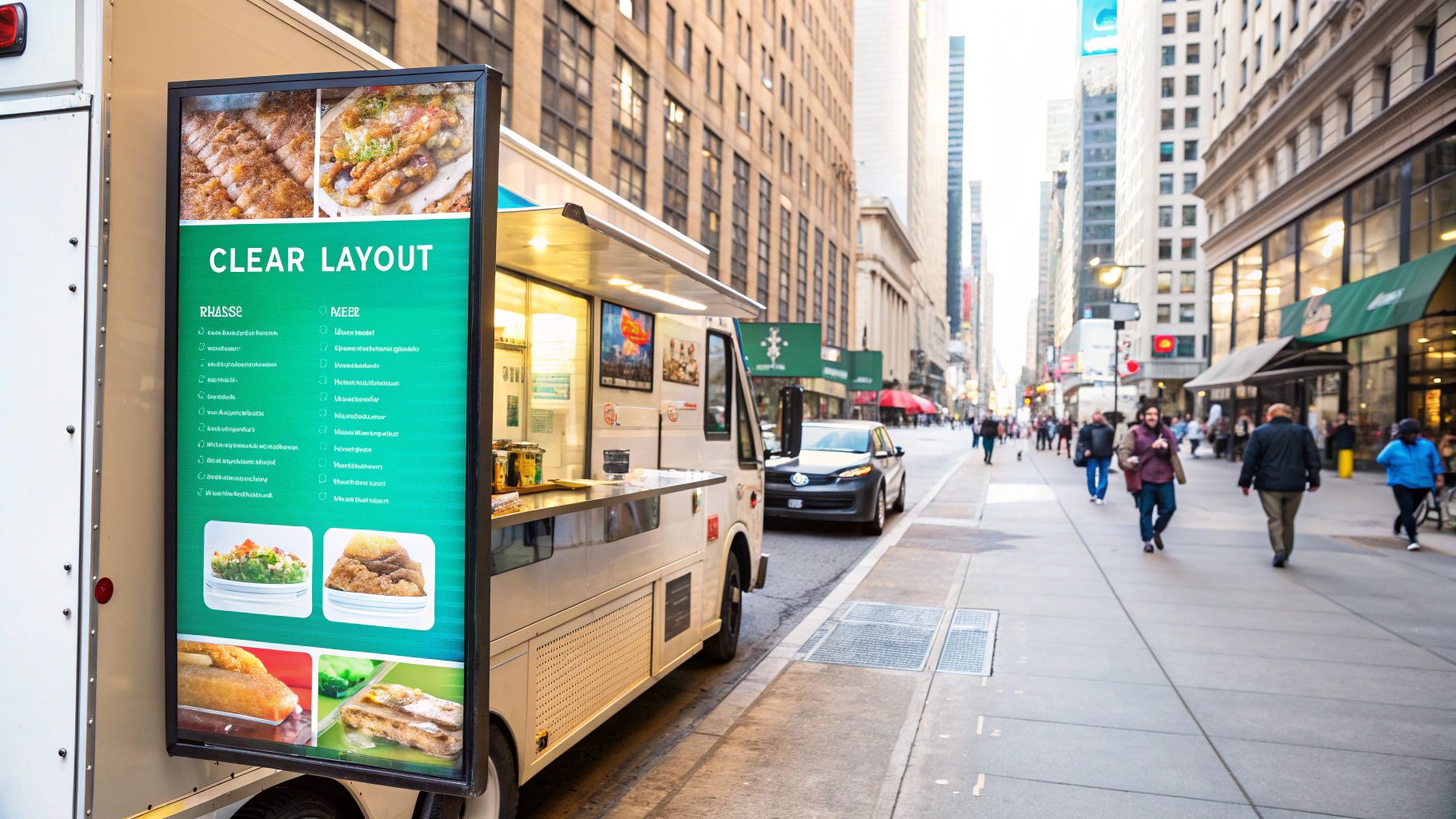
Choosing the right software for your food truck's digital menu board is just as important as the hardware itself. Trust me, I've seen countless operators struggling with complicated restaurant software, frantically trying to update menus during the lunch rush with spotty cell service. It's a nightmare.
What you need is software that's reliable even offline, syncs smoothly when you’re back online, and is user-friendly, even for non-designers. I know a food truck owner in Austin who raves about her cloud-based system. She updates specials from her couch the night before – easy peasy. Another operator in Denver swears by locally-stored content – no internet, no problem.
Finding the Right Fit: Cloud vs. Local
So, what’s the best option for you? Cloud-based solutions offer incredible flexibility. Think about changing prices or adding a new item from your phone, wherever you are. That’s the beauty of the cloud. But, there’s the catch – you're reliant on a good internet connection.
Local storage, on the other hand, gives you peace of mind when you're in a connectivity dead zone. Updates are done directly on the device, guaranteeing your menu is always displayed, internet or no internet. The trade-off? You have to be physically at the truck to make any changes.
Pricing and POS Integration: Must-Have Features
Now, let's talk money. Expensive enterprise-level software with a huge monthly subscription is unnecessary for most food trucks. Look for software with affordable pricing tiers designed for small businesses.
POS integration is essential. Streamlining orders and inventory saves you time and minimizes errors. But be warned, a poorly implemented integration can cause major headaches. Ask about seamless data flow and real-time menu syncing before committing.
Templates and Backup Solutions: Streamlining Your Workflow
Templates are a game-changer for fast menu updates. Opt for software with a good selection of customizable templates. Changing prices or swapping images should be as simple as drag and drop.
And let's be real, internet outages happen. That's why solid backup solutions are crucial. Automatic syncing ensures any offline changes are saved and uploaded the moment you have a connection.
Real-World Insights: From the Food Truck Front Lines
My final piece of advice? Don't just rely on slick sales demos. Talk to other food truck owners. Ask them what really works on the streets. Features that sound amazing in a presentation might be completely useless in the real world. Practical, on-the-ground experience is invaluable in finding the right software. From menu updates to order management, the right software can transform your food truck operation.
Menu Design That Guides Customers and Boosts Sales
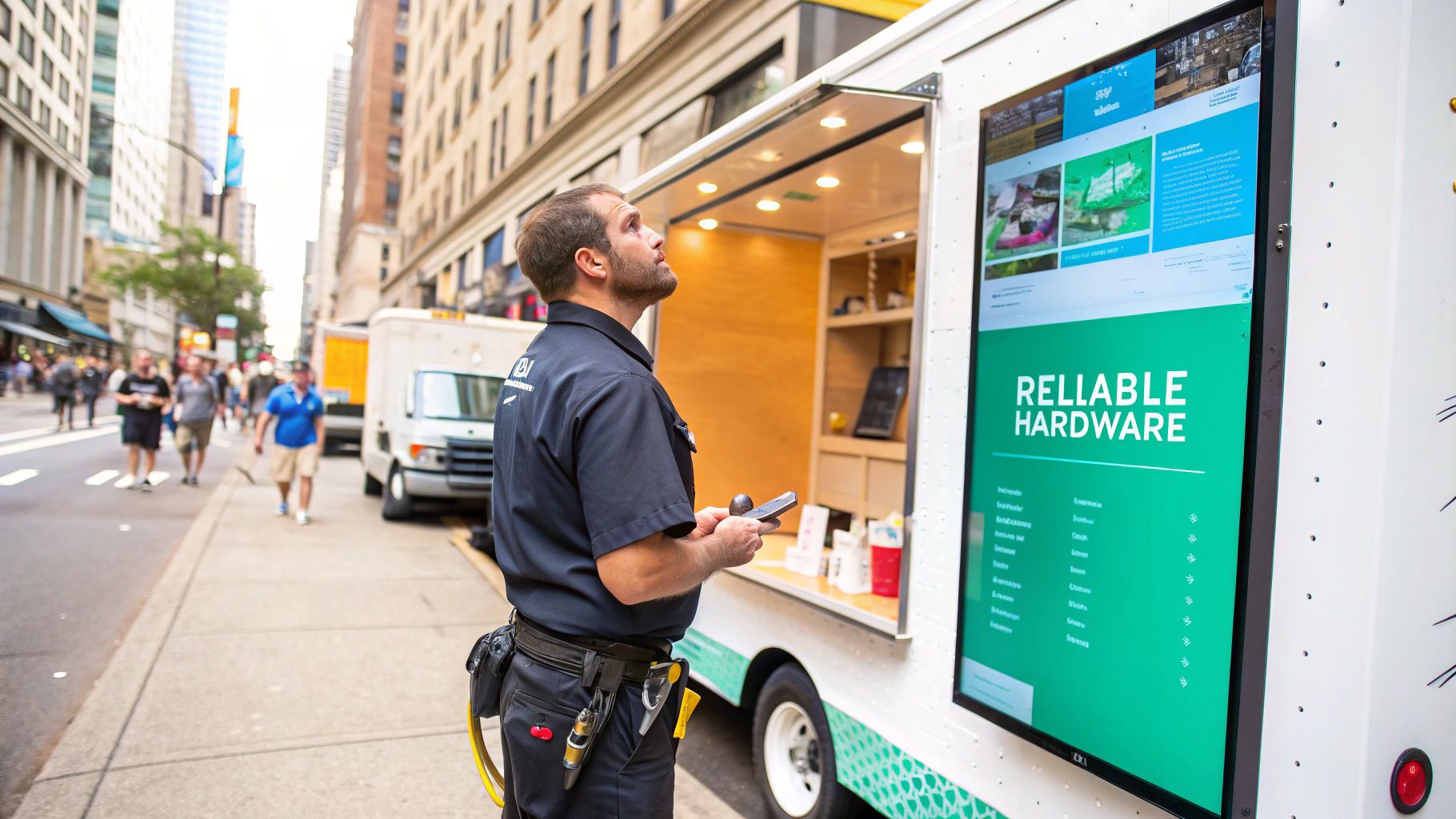
A slick digital menu board is pointless if it doesn't actually help your food truck rake in more cash and serve folks faster. I've spent a good chunk of time chatting with food truck owners and analyzing what truly clicks with customers, and trust me, there's a real art to it. Forget fancy graphics—it's all about steering those hungry eyes towards making a purchase. I know a taco truck owner who saw her average order jump by a whopping 30% just by tweaking her menu layout and using color strategically. That's the kind of power we're talking about.
Readability and Layout: Making a Great First Impression
Picture your customers: they're often checking out your menu from all sorts of angles and distances, sometimes squinting under the bright sun. That's why easy-to-read fonts are absolutely crucial. Opt for clear, bold fonts that are legible from afar. Skip the fancy script fonts – they might look cool up close, but they'll be a blur from a distance.
Your menu layout is just as important. Organize your offerings logically, grouping similar items together. Use visual cues like color blocks or borders to break things up and guide the customer’s gaze. A clear hierarchy, from entrees to sides, prevents that overwhelming feeling you get with crammed, old-school menus. Pro tip: positioning high-profit items at eye level, especially near the order window, can subtly influence choices.
Image Strategies and Pricing Techniques: The Subtle Nudges
Mouthwatering images of your food are a must, but make sure they're optimized for digital screens. Huge file sizes will slow your board down. Go for visually appealing images that load quickly. Think about showcasing your bestsellers or daily specials with larger, more prominent pictures.
Pricing strategy plays a key role, too. Avoid long, confusing price lists. Instead, bundle items into combo deals or highlight value-packed options. This makes deciding easier and encourages bigger orders. A simple "Meal Deal" with a small discount compared to buying items separately can significantly boost your average order value. If you're looking to spice up your menu descriptions, check out these Website Copywriting Tips.
Seasonal Changes and Keeping It Fresh: The Long-Term View
Don't be afraid to switch up your digital menu with the seasons. Highlighting fresh, seasonal ingredients keeps things interesting for regulars. But remember consistency. While new items are great, stick to a familiar structure so your loyal customers don't get lost. Small tweaks, like a seasonal banner or a limited-time offer, can have a big impact without a complete redesign. This keeps your menu fresh and exciting while providing a smooth customer experience.
Installation Without the Drama
Setting up a digital menu board in your food truck? It's more than just plugging in a screen. Think of your menu as the heart of your operation – and getting that digital display right is crucial. You'll want to plan your menu layout first. A helpful resource for menu design mockups is Menus Printing. I've seen food truck operators ace this, and I've seen some learn tough (and expensive) lessons. Here’s my take on avoiding the drama.
Planning Your Display Location: Prime Real Estate
Location, location, location! This is essential for your menu board’s success. Consider street visibility – can people walking by see it clearly? Think about power access – is there a convenient and safe outlet? How does the placement affect your workflow? I knew one operator who put their screen too close to the order window. Total bottleneck during the lunch rush. Another ran the power cable right through the prep area – a tripping hazard waiting to happen. Visibility, workflow, safety: plan these before you drill the first hole.
Mounting and Securing: Built to Last
Food trucks aren't exactly known for smooth rides. Potholes, sudden stops – your display needs to survive it all. Regular TV mounts? Nope. You want heavy-duty, vibration-resistant mounts. Locking mechanisms are a must. A friend of mine learned this the hard way. Sharp turn, screen came loose – disaster. He now swears by a reinforced mount with extra bracing. Overkill? Maybe. But his screen is rock-solid.
Power and Cable Management: The Unsung Heroes
Power is precious in a food truck. Your shiny new menu board needs a dedicated power source. Don’t skimp on surge protectors. I've seen displays fried by overloaded generators – a painful and avoidable expense. Cable management is equally vital. Loose cables? Tripping hazards. Damage from constant movement is inevitable. Zip ties and conduit are your friends. Not glamorous, but they save money and keep your crew safe.
Safety and Permits: Dotting Your I's and Crossing Your T's
Last but definitely not least: safety and regulations. Exposed wiring is a no-no. Proper grounding and shielding are crucial. Permits are another thing to keep in mind. Rules vary depending on your location, so check with your local authorities about permit requirements for external displays. I know someone who got slapped with a huge fine for skipping this step. Don't let that be you. Do it right from the start to avoid headaches (and fines) down the line.
Making It Work With Your Current Operations
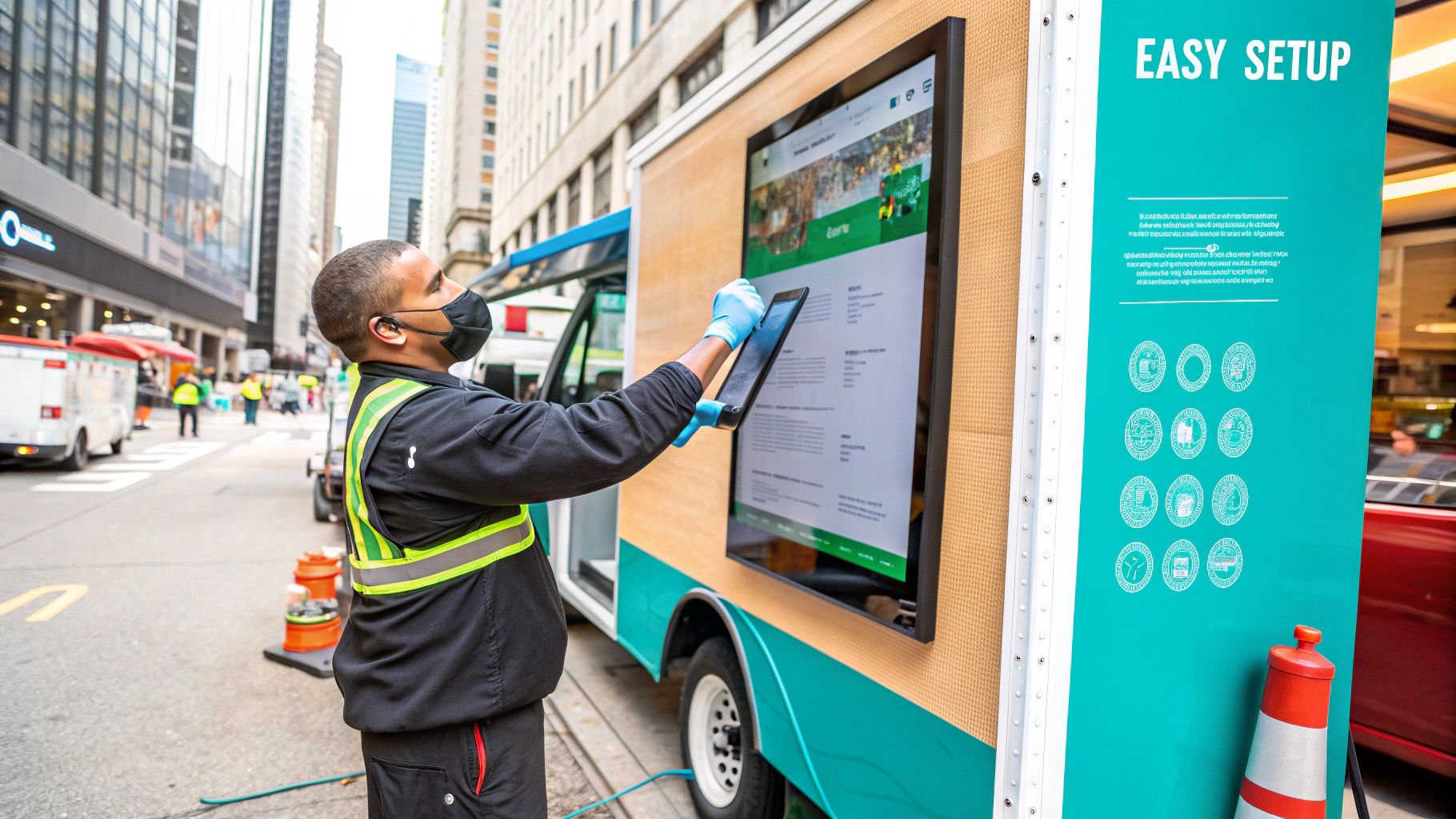
That shiny new digital menu board for your food truck is a real investment. Let's dive into how to make it work with your existing setup, not against it. Honestly, the most successful food truck owners I've seen are the ones who integrate their digital menus smoothly into their daily grind.
POS Integration: Friend or Foe?
Connecting your digital menu board to your POS (Point of Sale) system like Square or Toast can be a game-changer. Think about it: automatically updating your menu the second you sell out of the day's special. No more scrambling to manually change things during the lunch rush. But, here's the catch – this integration can be a real headache if not done right. Some systems are more trouble than they're worth. Ask yourself: Does the software sync in real time? What's the plan if your internet goes down? Can your team easily fix connection problems? A clunky integration can actually slow you down, so do your homework.
Inventory Management: Keeping It Simple
Updating your menu shouldn't take all day. I know a food truck owner who uses a simple spreadsheet linked to her menu software. At the end of the day, she updates the spreadsheet, and her menu updates automatically overnight. Genius! Find what works for you.
Staff Training: A Little Goes a Long Way
Your team needs to be comfortable using the new system. Everyone, from the cashier to the cook, should be able to handle basic updates – daily specials, sold-out items, price changes. Short training sessions before launch and quick reference guides posted near the display are lifesavers. When your staff can handle menu changes on their own, it frees you up to focus on what matters most – the food.
Social Media and Special Events: Maximize Your Reach
Your digital menu board is a marketing powerhouse. Use it to promote your social media accounts, showcase special events, and advertise limited-time offers. I've seen food trucks sync their menus with their Instagram feed, displaying customer photos alongside daily specials. It's a great way to build community and attract new customers. Another truck owner I know uses her board to advertise catering for local events. Think outside the box!
Transitioning Smoothly: Happy Customers, Happy You
Change can be a bit jarring. One clever food truck owner gradually introduced digital elements, keeping familiar menu items in their usual spots. This helped customers adjust and kept things feeling familiar while showcasing the new dynamic display. Little details like that make all the difference.
Troubleshooting Common Challenges: Be Prepared
Connectivity problems and software glitches happen. Have a backup plan for internet outages. Keep your software updated and know how to troubleshoot common issues. One truck owner I know keeps a printed menu on hand, just in case. Better safe than sorry, right? A little preparation can save you a lot of stress.
Getting Maximum Return on Your Investment
Now that your food truck's digital menu board is shining bright, let's talk about really making it work for you. I've seen firsthand how successful food truck owners use their boards as dynamic sales tools, not just static menus. Think of it as your silent salesperson, always on the job, enticing customers and boosting your profits.
Content Is King: Keeping Customers Engaged
Rotating your content strategically keeps things interesting. I know one owner who alternates weekly specials with customer testimonials and fun, behind-the-scenes shots of her food prep. It creates a mini-show for customers waiting in line, building loyalty and engagement. Another truck owner I know displays local event announcements, turning his truck into a community hub.
It's all about finding what resonates with your customers.
Upselling and Promotions: The Art of the Subtle Nudge
Digital menu boards are a fantastic way to highlight high-profit items and limited-time offers. Use vibrant visuals and tempting descriptions to showcase those money-makers. A countdown timer for a "today only" special can create a sense of urgency. Don't be afraid to experiment with different promotions to see what your customers respond to.
Maintenance Matters: Preventing Costly Repairs
This screenshot shows a sleek, modern digital menu board perfectly suited for a food truck. The clear layout, bright colors, and delicious-looking food photos immediately grab your attention. Smartly placing high-margin items and combo deals encourages upselling. Even the small touch of adding social media icons promotes online engagement. A well-designed board like this is a serious asset.
Just like regular maintenance keeps your truck running smoothly, it's crucial for your digital menu board, too. Simple weekly checks, like cleaning the screen and securing cables, can prevent major headaches (and expenses) down the road. It's a small investment of time that saves you big money in the long run.
Avoiding Common Pitfalls: Less Is More
I often see menus crammed with too many options or flashing content so rapidly it becomes a distraction. Resist the urge to overload your customers. Keep your menu concise and highlight your star dishes. Change content strategically, not just for the sake of change. A cluttered, constantly flashing menu can actually repel customers.
Measuring Success: What Really Matters
Forget vanity metrics. Focus on the numbers that directly impact your bottom line: average order value, customer dwell time, and repeat visit frequency. These are the real indicators of a successful digital menu board strategy. Track these over time to fine-tune your approach and maximize your return. Talking to other successful food truck operators can also give you valuable insights.
Ready to boost your food truck's online presence? Swish Web Designs specializes in creating custom online ordering systems and websites for food trucks and restaurants. They handle everything from design and development to SEO and maintenance, letting you focus on what you do best – making great food. Visit their site for a free consultation.


